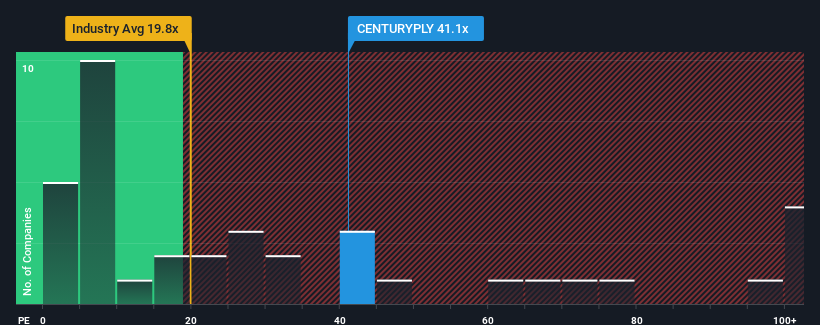- India
- /
- Paper and Forestry Products
- /
- NSEI:CENTURYPLY
Century Plyboards (India) Limited's (NSE:CENTURYPLY) Share Price Matching Investor Opinion

When close to half the companies in India have price-to-earnings ratios (or "P/E's") below 30x, you may consider Century Plyboards (India) Limited (NSE:CENTURYPLY) as a stock to potentially avoid with its 41.1x P/E ratio. Although, it's not wise to just take the P/E at face value as there may be an explanation why it's as high as it is.
With earnings growth that's inferior to most other companies of late, Century Plyboards (India) has been relatively sluggish. It might be that many expect the uninspiring earnings performance to recover significantly, which has kept the P/E from collapsing. If not, then existing shareholders may be very nervous about the viability of the share price.
Check out our latest analysis for Century Plyboards (India)

What Are Growth Metrics Telling Us About The High P/E?
In order to justify its P/E ratio, Century Plyboards (India) would need to produce impressive growth in excess of the market.
Retrospectively, the last year delivered virtually the same number to the company's bottom line as the year before. Although pleasingly EPS has lifted 155% in aggregate from three years ago, notwithstanding the last 12 months. Therefore, it's fair to say the earnings growth recently has been superb for the company.
Looking ahead now, EPS is anticipated to climb by 26% each year during the coming three years according to the ten analysts following the company. That's shaping up to be materially higher than the 20% per year growth forecast for the broader market.
In light of this, it's understandable that Century Plyboards (India)'s P/E sits above the majority of other companies. Apparently shareholders aren't keen to offload something that is potentially eyeing a more prosperous future.
What We Can Learn From Century Plyboards (India)'s P/E?
We'd say the price-to-earnings ratio's power isn't primarily as a valuation instrument but rather to gauge current investor sentiment and future expectations.
We've established that Century Plyboards (India) maintains its high P/E on the strength of its forecast growth being higher than the wider market, as expected. At this stage investors feel the potential for a deterioration in earnings isn't great enough to justify a lower P/E ratio. Unless these conditions change, they will continue to provide strong support to the share price.
The company's balance sheet is another key area for risk analysis. Our free balance sheet analysis for Century Plyboards (India) with six simple checks will allow you to discover any risks that could be an issue.
Of course, you might also be able to find a better stock than Century Plyboards (India). So you may wish to see this free collection of other companies that have reasonable P/E ratios and have grown earnings strongly.
New: AI Stock Screener & Alerts
Our new AI Stock Screener scans the market every day to uncover opportunities.
• Dividend Powerhouses (3%+ Yield)
• Undervalued Small Caps with Insider Buying
• High growth Tech and AI Companies
Or build your own from over 50 metrics.
Have feedback on this article? Concerned about the content? Get in touch with us directly. Alternatively, email editorial-team (at) simplywallst.com.
This article by Simply Wall St is general in nature. We provide commentary based on historical data and analyst forecasts only using an unbiased methodology and our articles are not intended to be financial advice. It does not constitute a recommendation to buy or sell any stock, and does not take account of your objectives, or your financial situation. We aim to bring you long-term focused analysis driven by fundamental data. Note that our analysis may not factor in the latest price-sensitive company announcements or qualitative material. Simply Wall St has no position in any stocks mentioned.
About NSEI:CENTURYPLY
Century Plyboards (India)
Manufactures and sells plywood, laminates, decorative veneers, medium density fiber boards (MDF), pre-laminated boards, particle boards, and flush doors in India.
Reasonable growth potential with mediocre balance sheet.
Similar Companies
Market Insights
Community Narratives



